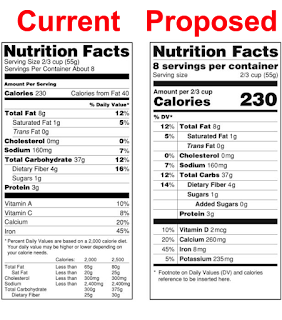Learn How the NEW Nutrition Facts Label Can Help You Improve Your Health
The US Food and Drug Administration (FDA) issued new regulations changing the Nutrition Facts label external on packaged foods. This is the first major change to the label since it was introduced in 1994. The changes are based on updated science, the most recent dietary recommendations, external, and public input. Using the new label can help you choose foods for a healthy diet. The label will be required on all packaged foods made in the United States and imported from other countries. The new label is already appearing on packages. Most items will have the new label by January 1, 2021.
What is changing?
Calories & Fat
Larger, darker letters make calories the easiest item to see on the new label. When it comes to health outcomes, the type of fat you eat matters more than the overall amount of fat. For this reason, the label will no longer show the percentage of “calories from fat” but will show percentages from the unhealthy saturated and trans fats.
Added Sugars
In addition to showing the total percentage of calories from sugars, labels will show the percentage from added sugars. This will help you choose products that have lower amounts of added sugar for your diet. Less than 10% of your daily calories should be from added sugars.
Did you know that the two main sources of added sugars in the United States are sugar-sweetened beverages and snacks and sweets, including candies and desserts? If you tend to eat or drink even one large serving of these foods or beverages per day, then you are likely getting more than the recommended daily limit of added sugar.
Serving Size
Serving sizes on the new label are changing. Twenty years ago, people tended to eat smaller amounts than they do now. The new serving size reflects what people are likely to eat or drink today and not necessarily the portions they should eat.
For example, the serving size of ice cream was ½ cup but will be ⅔ cup. A 12 ounce or 20-ounce bottle of soda will be labeled as 1 serving since people are likely to drink either size at one time. This is intended to give people a more realistic view of the number of calories they are consuming.
Dual Column Labels
Some food and drink packages contain more than one serving, but a person may consume the whole package's contents at one time, for example, a pint of ice cream or a bag of chips. Two columns provide calorie and nutrition information for one serving and for the whole package.
Updated Required Nutrients

- Vitamin D and potassium values will now be required on the label.
- Calcium and iron will continue to be required.
- Vitamins A and C will no longer be required but can be included voluntarily.
Slight Decrease in Sodium Allowance
- The daily limit for sodium will decrease slightly from 2,400 mg per day to 2,300 mg per day. This change matches the recommendation in the Dietary Guidelines for Americans, 2015-2020.
The new Nutrition Facts label is on some packaging now, but won’t appear on all food and drink packaging until 2019. Until then, here are a few tips (based on the Dietary Guidelines for Americans, 2015-2020) to help you make healthier choices about what you eat and drink.
- Keep your intake of added sugars to less than 10% (e.g., 200 calories if you consume 2,000 calories in a day) of your total daily calories. Naturally occurring sugars, such as those in fruit or milk, are not added sugars. If “added sugars” are not yet on the label, use the ingredient list to find added sugars such as brown sugar, maple sugar, corn sweetener, corn syrup, honey, malt syrup, and molasses.
- Read the Nutrition Facts labels on your packaged food and drinks to keep track of sugars, fats, protein, and other nutrients.
- Most of the sodium we consume is in the form of salt. In most people’s diets, the majority of salt comes from processed and restaurant foods. Read labels and choose the product with less sodium.
- Drink plain water instead of sugary beverages to reduce the number of calories and added sugar you consume. Read the Nutrition Facts label on a product to see how many calories are in your drink.
- Limit the serving size of the treats you eat. If you are going to have dessert, keep it small. Take the Portion Distortion Quiz and learn how food portion sizes have changed in 20 years.
- Be sure you know how many servings are in the food you are eating. For example, if you buy what looks like an individual-sized chicken pie, check the Nutrition Facts label before you assume that the whole pie is one serving. It might actually be two servings. If you eat the whole pie, you will eat twice as many calories, twice as much sodium, and other nutrients listed on the label.







Comments
Post a Comment